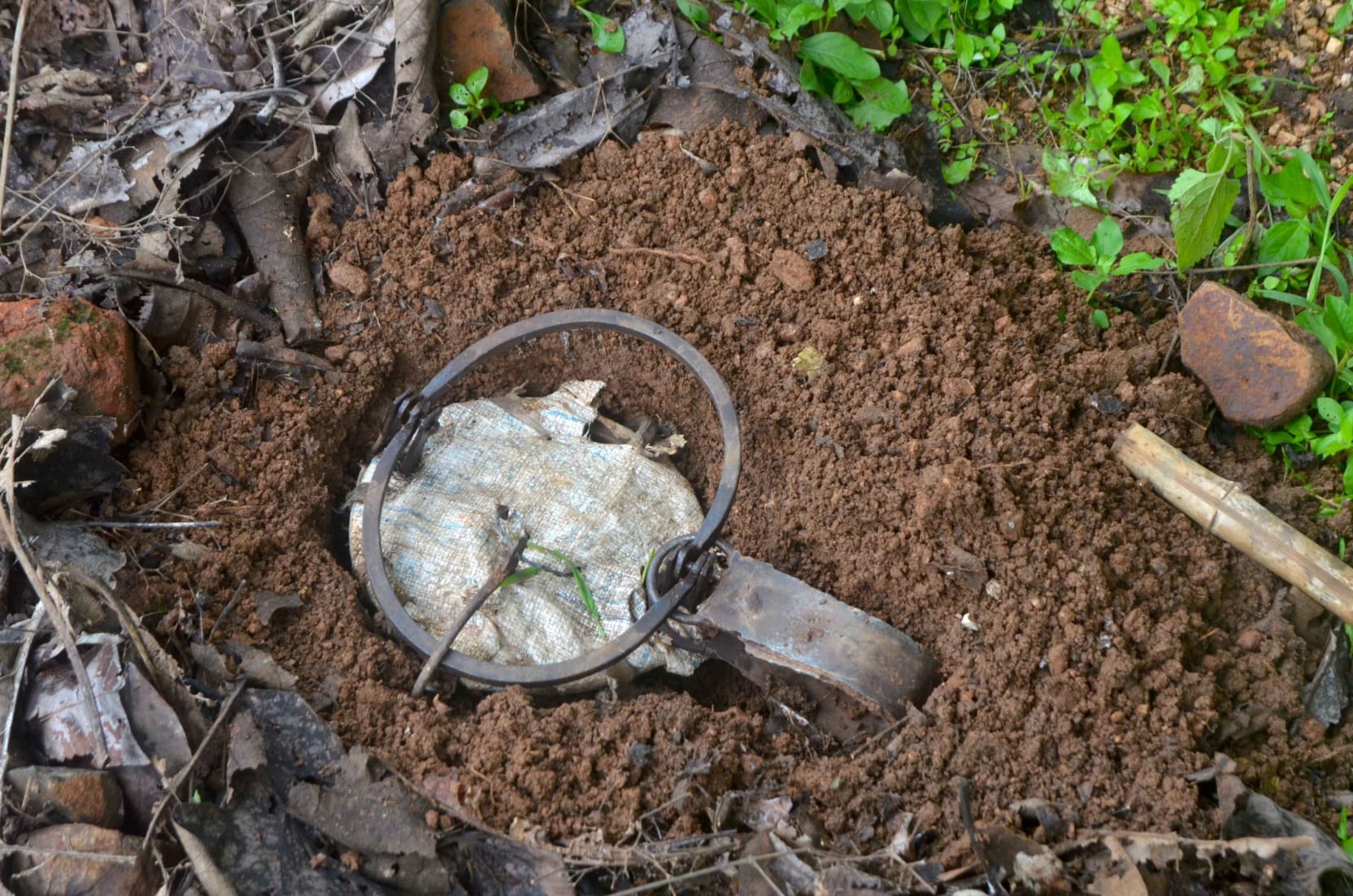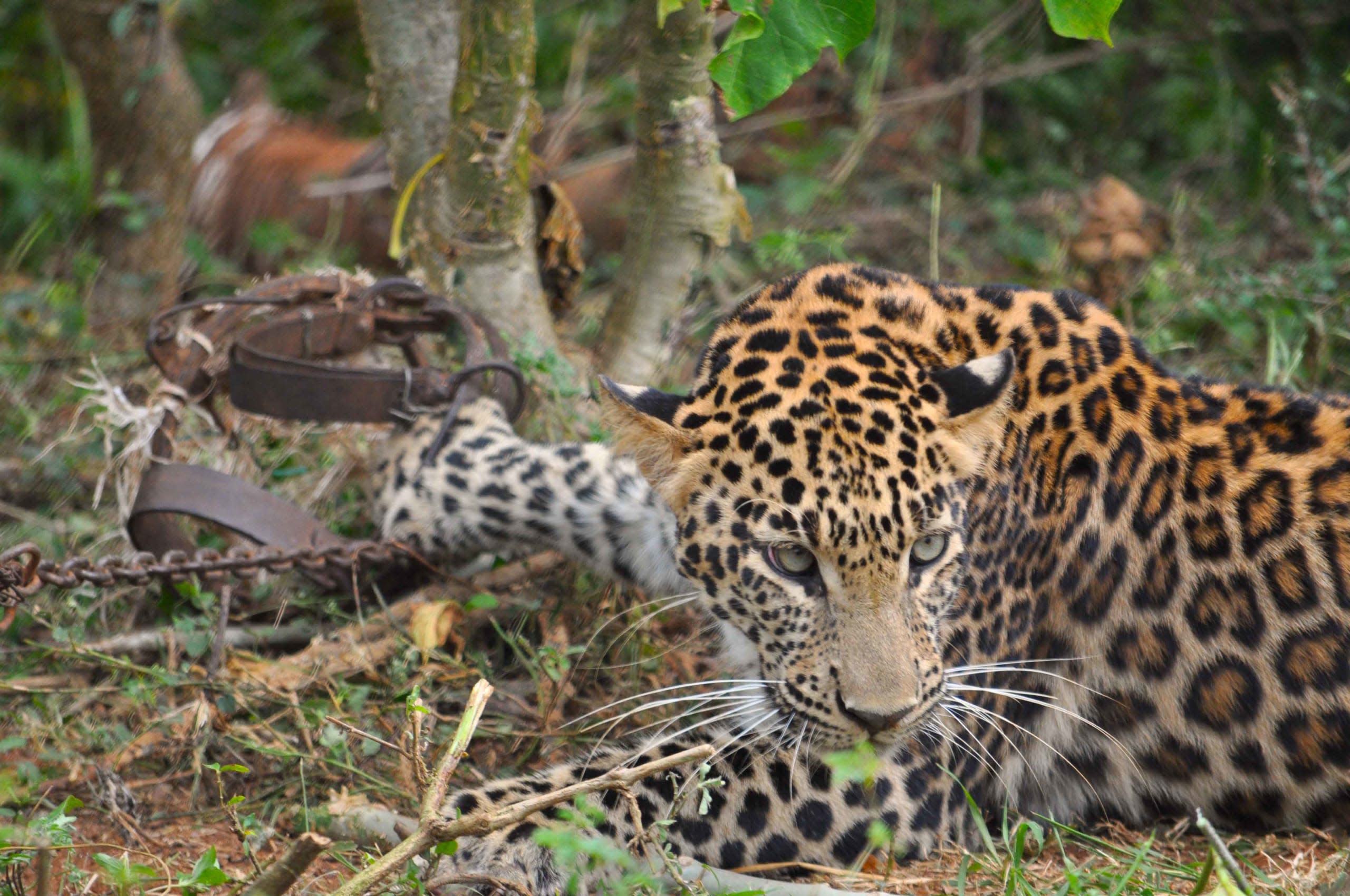 Listen to this article
•
15:34 min
Listen to this article
•
15:34 min
Sunday, the 12th of November 2022. Usually, a day for laundry, groceries, and some much-needed rest — or a day to go out and explore. The chilly winter morning breeze, a clear blue sky and the warm, soothing sunlight won’t let you stay indoors, especially in Nagarhole. We headed to the nearby tribal settlement and took to strolling around the hamlet and interacting with residents. Our team, from Wildlife Trust of India’s field station nearby in Antarasante, had been working with the local community for over a year. Accompanying me were field officer Hareesha, and Field Assistant, Ajith. We were working with the Karnataka Forest Department, and supported by Fondation Segré, on wildlife crime enforcement assistance. But the calmness was short-lived. Our stroll was interrupted by a call from the Range Forest Officer. There was a sense of urgency in his voice.
We rushed to the location immediately. A big, curious crowd had already surrounded the area. After setting up a perimeter and ensuring that the crowd was kept away, we were ready to close in. A partly decomposed body of a tigress was lying in a ditch. Upon close observation, we found a thin wire, like the ones used for a motorcycle clutch, running from the neck of the tigress to the base of a tree where the snare was secured. This was the first time I was so close to an animal snared to death.

Cover Photo: A leopard caught in a specialised leg hold trap (called kadka in the Pardhi language). These traps are designed by professional hunters and are used to trap big cats. The Karnataka Forest Department rescued this individual. Photo: Jose Louies
Death by a snare
On the bark and around the tree were marks of struggle. The tigress must have tried hard to free herself. Claw scratch marks were everywhere, and the animal had even tried biting off the wire. Eventually, it must have been a slow, painful death. With a snare like this, the harder she struggled, the tighter the snare would have gripped her neck. Suffocation would have been followed by limb paralysis, and eventually, the pressure was so high that her eyes had popped out. The snare’s grip was so tight that she wouldn’t have been able to make any sound. The wire would have slowly torn through her skin and neck muscles.
This tigress, popularly called the “Nayanjikatte female”, was a mother of three cubs. The team knew her from various camera trap images over the years. When she got caught in the snare, she had three nine-month-old cubs. Perhaps they helplessly witnessed her painful death. We will never know what they experienced or felt, but as evident from pugmarks at the site, they were in the vicinity at the time of her death. It was just one single snare, but it had destroyed a family by orphaning three cubs who now had a much lower chance of surviving in the wild on their own.

Wires that kill
A snare is a simple tool made from any material, including a fence wire, motorcycle clutch cable, nylon rope, cloth, plastic, or even a vine. It is cheap, works silently, and is mostly undetectable — a deadly tool. Usually, snares such as these are used to trap spotted deer and wild boars for bush meat. But the snare doesn’t discriminate or select its victims; it can also take the lives of tigers, leopards, and even elephants.
Snares have been commonly used across the world to hunt bush meat. They come in various shapes and sizes and are designed to trap anything ranging from birds to large mammals. They bring the advantage of disguise wherein the hunter can be several kilometres away in his home and expect to find a trapped animal when he comes back in a day or a week. Snares are silent, unlike gunshots. Something as easily available as a discarded brake cable can become a lethal weapon.
The trick to successful snares is understanding animal behaviour and fluency with their landscapes and microhabitats. Jaydeep Markam (name changed on request), a resident of Zidar village near Udanti Wildlife Sanctuary, Chhattisgarh, says, “We know the lay of the land like the back of our hands. We are aware of where exactly chital herds gather in the evening and which route they take to reach the waterholes. It’s just a matter of placing the snares in the right place. I could guarantee a catch if it weren’t illegal!”. It’s scary but also points to the truth about the efficacy of snares and their widespread use.

In 2022, an elephant was trapped in a snare near the Similipal Tiger Reserve, Odisha. The snare, made of plastic rope, had already cut through ten inches of skin when the bull elephant was located by forest department staff. The elephant died a couple of days after the initial treatment for septicemia. “Snares such as this are usual. It could very well have been a discarded cow hitch in which the elephant got its leg trapped,” says Dr Indramani Nath from the Odisha University of Agriculture and Technology (OUAT), who led the veterinary team in the operation. “The important thing is to note how a simple rope can act as a killing device and bring down an elephant”, adds Nath.
Nail in the conservation effort coffin
Remember Mahaveer? The tiger was translocated from Bandhavgarh to Satkosia Tiger Reserve, Odisha, in 2018. It was the first interstate tiger translocation effort in India, meant to boost the population of the national animal in this landscape. The exercise involved years of strategising, sociological studies, habitat surveys, and more, costing crores in conservation money and human resources. Within months after being translocated, the tiger got trapped in a snare and was killed, halting the re-populating exercise. One can easily understand the setback that a single snare brought.

Extent of the damage
Illegal hunting and poaching are among the largest threats to the conservation of many threatened and flagship species globally. South Asia accounts for about 15 per cent of the world’s biodiversity but is also plagued with biodiversity loss and wildlife crimes. Among South Asian countries, India is distinctively placed as a key source of wildlife parts and products entering the illegal market. The demand for rare species further drives illegal poaching, especially for animals believed to have medicinal properties or are highly valued in the exotic pet market. Poached wild animals (alive or body parts) also make their way to markets in China, Southeast Asia, the Middle East, Europe, and even North America.
Snares are also increasingly used to deal with animals that eat crops. Understanding that crop compensation is a technical, long-drawn-out procedure, some farmers may resort to using snares to prevent crop raiding by plant-eating wild animals. Again, victims include both wild boars and leopards. “When a tiger or a leopard accidentally gets trapped and killed in a snare meant for wild boars, it is natural for the snarer to try and hide the evidence,” says Jose Louies, Chief of Enforcement at Wildlife Trust of India. He adds that, sometimes, the farmer may find connections to poachers and try to sell the snared animal’s body parts. If they make a successful transaction, this could lead them to set the next trap to target the same species and make money in the illegal wildlife trade market. “Snaring isn’t limited to protecting crops anymore,” Mr Jose continues.
The threat of snares is such that wildlife experts firmly believe it is the reason for the extinction of the wild tigers in Laos, Cambodia, and Vietnam. A similar story of extinction by poaching was scripted for India’s tiger reserves. However, better enforcement helped tigers evade that fate.

Anti-snare walks
In January 2022, the National Tiger Conservation Authority (NTCA) mandated Anti-Snare Walks (ASW) across all the tiger reserves in the country. ASWs are patrolling walks, usually in the early hours of the day, along the borders of protected areas where human settlements and agricultural fields are present. It takes a lot of concentration and skill to spot hidden and disguised snares, but it’s worth the effort.
For the people involved, the activity can last beyond a week or even 15 days. Spending so much time and resources to recover a couple of snares might seem unreasonable. But now, I know why. Each of these snares had the potential to kill a family of tigers. Wildlife Trust of India, an NGO that pioneered ASWs, started these patrolling exercises with the help of locals, who were once hunters. “There is no better candidate to identify snares than the ones who know how to lay them”, adds Jose.
Looking back at that fateful November morning of 2022 still sends shivers down my spine. One of the cubs was found killed, possibly in a territorial fight with another adult male, about 15 days after the incident. The remaining two cubs were never located, and we can only hope that somehow they survived. It is up to us to ensure that no other tigers (or wildlife) face the same fate.





